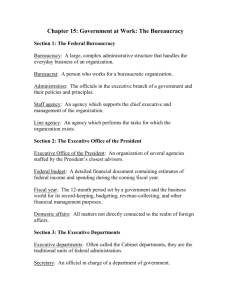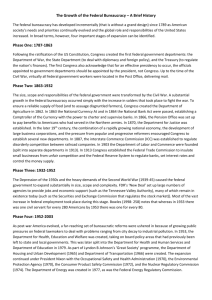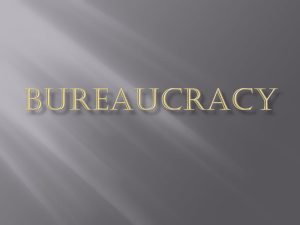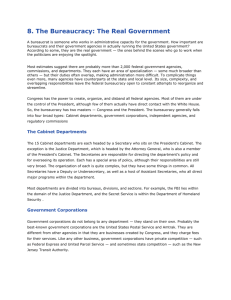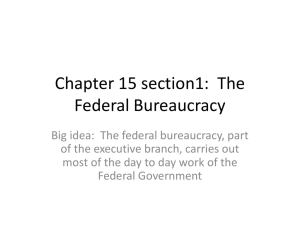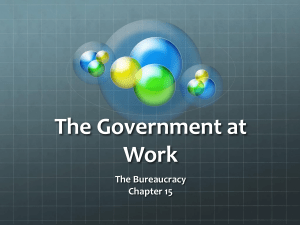The Bureaucracy
advertisement
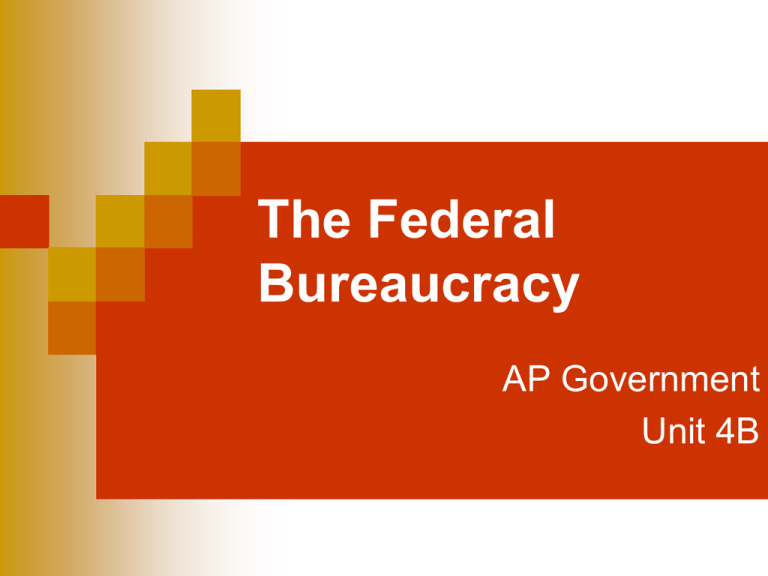
The Federal Bureaucracy AP Government Unit 4B Bureaucracy Professional corps of unelected officials organized in a pyramid hierarchy, functioning under impersonal uniform rules and procedures. Bureaucracy literally means “rule by desks” Characteristics Administration of government through departments Consists of unelected often highly trained professionals Task specialization Hierarchical authority Impersonal Inclined to follow rigid or complex procedures May stifle effectiveness and innovation Red tape Parts of the Executive Branch AKA…The Bureaucracy President Executive Office of the President Independent Agencies, Boards & Commissions Includes White House Staff Executive Branch Departments Makes up the main portion of the Cabinet U.S. Department of Justice Organizational Chart Federal Bureaucracy Mechanism that carries out day to day business of government. Created to carry out broad range of tasks, to provide necessary services, and to act as experts in particular areas of policy. Grown to 2.8 million civilian employees AKA the Fourth Branch The Bureaucrats Who They Are and How They Got There Most demographically representative part of government. Diversity of jobs mirrors private sector. Figure 15.2 Weberian Model of Bureaucracy Political process controlled by political elites in bureaucracy Bureaucrats use model to make government more efficient, run like well-organized machine Hierarchical authority structure Task specialization Operate on merit principle Behave with impersonality Organization of Federal Bureaucracy Consists of: EOP Executive departments Independent agencies Government corporations President Executive Office of the President Includes Executive Departments Independent Executive Agencies Independent commissions regulatory Independent Agencies, Boards & Commissions Executive Office of the President “The EOP” Not a single office or department, but a collection of agencies that are directly responsible for helping president deal with Congress and manage larger executive branch. President Executive Office of the President Independent Agencies, Boards & Commissions Executive Departments Parts of the EOP: White House Staff White House staffers are usually Former campaigners, trusted workers Hired and fired at will of president Most powerful White House Staffer is Chief of Staff Chief of Staff one of President's closest advisers, also close friend. Nicknamed "the gatekeeper." Responsible for overseeing actions of other members of White House staff, managing president's timetable, and controlling outsiders' access to president. Executive Office of the Presidency “EOP Agencies” Report directly to President Most important agency Office of Management and Budget (OMB) Other important EOP agencies National Security Advisors (NSA) Council of Economic Advisors EOP agency heads hired and fired at will Congress not involved with approval Executive Departments Department heads advise President on policy issues and help execute policies. Each Executive Department also part of President’s Cabinet Cabinet not mentioned in Constitution Created first by Washington Cabinet secretaries appointed by president and need Senate approval President controls Cabinet Considered “yes” men and women! Don’t disagree (in public at least!) Executive Departments 14 Cabinet Departments 15 Executive Departments headed by a secretary Department of Justice headed by Attorney General Each has own budget, staff and policy areas Some Republicans (and Libertarians) have been trying to eliminate several departments including Education and Energy The Executive Departments Agriculture 8. Housing and Urban Development Commerce 9. Interior Defense 10. Justice Education 11. Labor Energy Health and Human 12. State Services 13. Transportation 7. Homeland Security 14. Treasury 15. Veteran’s Affairs 1. 2. 3. 4. 5. 6. http://www.whitehouse.gov/government/cabinet.html Example “The Department of the Interior” Figure 15.4 Independent Agencies and Commissions Government offices that report to President but have more independence (AKA Quasi- Independent) FDIC, CIA, SEC, EPA… Make regulations to help implement laws Don’t report to president for instructions Deal with own issues and staff independently President appoints agency heads for fixed terms Agency heads must be approved by Congress Can be removed only for “a just cause” Independent Regulatory Agencies (IRA’s) Independent of executive departments. Meant to impose and enforce regulation free of political influence, help carry out policy or provide special services. Securities and Exchange Commission Consumer Product Safety Commission IRAs run by board rather than 1 person. President appoints board members, members serve terms longer than single Presidential term Board members also appointed at different times, so unable to stack Boards or Commissions. The Independent Regulatory Agencies Responsible for some sector of economy making rules and judging disputes to protect public interest Example: Food and Drug Administration and Interstate Commerce Commission Headed by commission of 5-10 people. Rule making important function watched by interest groups and citizens alike. Concern over “capture” of agencies by Congress or President (want to remain independent!) The Government Corporations Similar to Independent Agencies but more “Business-like” entities Provide service like private companies and typically charges for services. Designed to run like businesses and hopefully generate profit (Postal Service, Amtrak) Independent Executive Agencies Agencies that don’t fit in anywhere else. NASA About 1,000 of the more than 7,000 presidentially-appointed positions to be filled during any presidential transition process require confirmation by a majority vote of the U.S. Senate. 1. Secretaries of the 15 Cabinet agencies, deputy secretaries, under secretaries and assistant secretaries, and general counsels of those agencies: Over 350 positions. 2. Certain jobs in the independent, non-regulatory executive branch agencies, like NASA and the National Science Foundation: About 120 positions 3. Director positions in the regulatory agencies, like the Environmental Protection Agency and the Federal Aviation Administration: 130 positions 4. U.S. Attorneys and marshals: About 200 positions 5. Ambassadors to foreign nations: 150 positions 6. Presidential appointments to part-time positions, like the Board of Governors of the Federal Reserve System: 160 positions http://usgovinfo.about.com/od/thepresidentandcabinet/a/sentateconfirm.htm What Roles Do Government Bureaucrats Perform? Communicate with each other Maintain paper for accountability Enforces/carries out law Implement objectives of organization. Congress delegated significant amount of authority to bureaucracy by granting agencies power to draft federal regulations (rulemaking) Changes in Bureaucracy Prior to 1883, bureaucrats were political appointees—result of spoils system or patronage. Civil Service Act of 1883 created merit system for hiring of bureaucrats. How Do Bureaucrats Get Their Jobs Today? Most must apply Office of Personnel Management Federal office in charge of most of government’s hiring. Merit System: Entrance exams and promotion ratings to find people with talent and skill. System of hiring and promotion based on merit and nonpartisanship Sample Civil Service Exam Questions Which of the following pairs of words has the OPPOSITE meaning? guarded-suspicious legendary-mythical expeditious-leisurely rancid-putrid delicate-frail Sample Civil Service Exam Questions Which of the following pairs of words has the OPPOSITE meaning? guarded-suspicious legendary-mythical expeditious-leisurely rancid-putrid delicate-frail Sample Civil Service Exam Questions Look at this series: 44, 44, 50, 50, 56, . . What number should come next? 44 48 56 62 Sample Civil Service Exam Questions Look at this series: 44, 44, 50, 50, 56, . . What number should come next? 44 48 56 62 Sample Civil Service Exam Questions Which of the following pairs of words has the SAME meaning? sly-cunning infallible-weak decisive-hesitant predictable-mysterious derisive-complimentary Sample Civil Service Exam Questions Which of the following pairs of words has the SAME meaning? sly-cunning infallible-weak decisive-hesitant predictable-mysterious derisive-complimentary Sample Civil Service Exam Questions Choose the correct sentence from the following list. The search took place without incident, except for a brief argument between two residents. The search took place without incident. Except for a brief argument between two residents. The search took place. Without incident except for a brief argument between two residents. The search, took place without incident except, for a brief argument between two residents. Sample Civil Service Exam Questions Choose the correct sentence from the following list. The search took place without incident, except for a brief argument between two residents. The search took place without incident. Except for a brief argument between two residents. The search took place. Without incident except for a brief argument between two residents. The search, took place without incident except, for a brief argument between two residents. Bureaucracy “Personalities” Tend to take on own ‘personalities’ Conservatives dominate Dept. of Defense Liberals dominate social service departments like Education and Health and Human Services Other examples: “Activist” bureaus and agencies: EPA, FDA, Federal Trade Commission “Traditional” bureaus and agencies: Agriculture, Treasury, and Commerce TOP Jobs Recruitment for top bureaucratic jobs from Plum Book Published by Congress Lists very top jobs available for Presidential appointment. Use patronage to find applicants Ambassadorships, Presidents positions. top level officials… find “capable people” to fill Discretionary Authority Real power: ability for bureaucrats to choose courses of action and make policies that affect all Americans “Discretionary authority” can carry weight of laws for general public and businesses/corporations Examples: Safety features on cars Pollution emission standards Product standards How Presidents Try to Control Bureaucracy Appoint right people. Issue executive orders. Tinker with agency’s budget. Reorganize agency. Executive Branch IMPLEMENTS Laws What Implementation Means Involves translating goals and objectives of policy into operating, ongoing program for chief executive. In other words….making law work in real world! Creating / assigning an agency policy Turning policy into rules, regulations and forms. Coordinating resources to achieve goals. How Congress Tries to Control the Bureaucracy Influence presidential appointments. Tinker with agency’s budget. Hold hearings. Rewrite legislation or make it more detailed. Congressional Connection Congress appropriates funds for bureaus and agencies Appropriations Committee held majority of power Committee has lost some of its power due to: Trust funds operate outside regular government budget to assure citizens services and benefits Social Security Annual Authorizations gives whole Congress chance to voice opinion yearly on appropriations for bureaus and agencies Recent budget deficits have meant Congress trying to reduce spending Committee Clearance Informal way Congress can still control bureaucracy Congress may obtain right to void decision of bureau or agency chief May be political or personal reasons Legislative Veto Requirement that executive decision must lie before Congress for specified period before takes effect Congress could review and VETO decision if both Houses agreed Supreme Court asked to rule on this practice in Chadha case INS v. Chadha (1983) Mr. Chadha stayed in U.S. past visa deadline and ordered to leave country. Immigration Service allowed him to stay because of complications and extreme hardship House suspended INS’s deportation ruling using what was called “Legislative veto”. Question of law: Did Congress which allowed a legislative veto of presidential actions, violate the separation of powers doctrine? Importance Court said “Yes!” Court ruled that Act violated Constitution Chief Justice Burger concluded even though Act would have enhanced governmental efficiency, violated "explicit constitutional standards" regarding lawmaking and congressional authority. Legislative veto declared unconstitutional. The Peter Principle “In a hierarchy every employee tends to rise to his level of incompetence." Formulated by Dr. Laurence J. Peter in 1968 book Pertains to level of competence of human resources in hierarchical organization. Explains upward, downward, and lateral movement of personnel within hierarchically organized system of ranks. Understanding Bureaucracies Iron Triangles and Issue Networks triangle: “mutually dependent relationship between bureaucratic agencies, interest groups, and congressional committees or subcommittees”. Exist independently of each other. Tough but not impossible to get rid of. Some argue iron triangles being replaced by wider issue networks that focus on more policies. Iron The Iron Triangle Describes cozy relationships in US politics between 3 entities: Legislative Branch (especially subcommittees) Bureaucracy Lobbyists and interest groups The Legislative Branch (especially subcommittees) Who Benefits from the Iron Triangle? Powerful interest groups Members of Congress Federal employees Consumers are often left out in the cold by this arrangement. Result in passing of very narrow, “pork barrel” policies A Divided Government Kills Iron Triangles (or maybe only maims them!) Only when Congress and White House both controlled by same party can strong alliances between branches form divided government can stop these alliances When legislative and executive branch have conflicting political agendas, make cozy relationships nearly impossible. The 21st Century Iron Triangle Issue Networks “Iron triangle” fallen out of favor among political scientists because no longer accurate description of changed political dynamics. Issue networks: new term to describe looser and broader coalitions of today Rarely find just 2 competing sides to an issue anymore Issue Networks These groups constantly changing/adapting in Issue Networks unlike Iron Triangle which generally stayed static Agency Officials Members of Congress Interest Groups Lawyers Consultants Public Relations Experts The Courts Important Bureaucratic Regulatory Acts 8. 9. 1. 2. 3. 4. 5. 6. 7. Pendleton Act (1883) Hatch Act (1939) Administrative Procedure Act (1946) Freedom of Information Act (1966) National Environmental Policy Act (1969) Rehabilitation Act (1973) Budget Reform Act (1974) 10. 11. 12. 13. 14. Privacy Act (1974) Open Meeting Law (1977) Civil Service Reform Act (1978) Whistle Blower Act Protection Act (1989, 93-01) National Performance Review (1993) Federal Employees Political Activities Act (1993) The E-Government Act of 2002 Pendleton Civil Service Reform Act (1883) Established US Civil Service Commission which placed most federal employees on merit system and marked end of so-called “spoils system”. Hatch Act (1939) Main provision: prohibit federal employees (Civil Servants) from engaging in partisan political activity. Bureaucrats may NOT become involved in political campaigns Named after Senator Carl Hatch of NM, law was officially known as “An Act to Prevent Pernicious Political Activities”. Administrative Procedure Act (1946) Governs way in which agencies propose and establish regulations Freedom of Information Act (1966) Assures media and private citizens a legal right to government information AKA “Open Records Laws” or “Sunshine Laws” Requester doesn’t usually have to give explanation for request, but if information not disclosed a valid reason has to be given. The National Environmental Policy Act (1969) Requires federal agencies to integrate environmental values into decision making processes by considering environmental impacts of proposed actions and reasonable alternatives to those actions Rachel Carson’s book, Silent Spring, instrumental in continued support of NEPA Rehabilitation Act (1973) Includes variety of provisions focused on rights, advocacy and protections for individuals with disabilities. "Handicapped" if he or she: Has mental or physical impairment which substantially limits one or more of such person's major life activities; Has record of such impairment/regarded as having such impairment. Budget Reform Act of 1974 Congressional effort to control presidential impoundments. Requires president spend all appropriated funds. If Congress notified of which funds will not be spent and, within 45 days, agrees to delete items, money can be saved. If president wishes to delay spending money, Congress must be informed and may refuse delay by passing resolution requiring immediate release of funds. The Privacy Act (1974) Protects citizens from obtrusive searches into private lives Specific exceptions for record allowing use of personal records: The Federal Census Department of Labor Statistics For routine uses within a U.S. government agency For archival purposes "as a record which has sufficient historical or other value to warrant its continued preservation by the United States Government" For law enforcement purposes For Congressional investigations Other administrative purposes (Patriot Act- 2002 and 2006) Federal Open Meeting Law (1977) Opened doors for media and private citizens to more than 50 federal boards and agencies. All agencies under act must announce meetings at least a week in advance. Closed session allowed under specific circumstances, but reason for closed meeting must be certified by legal officer of agency. Civil Service Reform Act of 1978 Attempted to reform civil service of federal government Addressed incompetent workers, automatic pay increases, and lack of incentive for good work Not successful in any of these areas. The Whistleblowers Protection Act (1989, 1993, & 2001) Designed to protect people who come forward with disclosure about improper conduct by public bodies or public sector employees. Thus…the name “whistleblower” National Performance Review 1993 Created during Clinton Administration by VP Al Gore. Often called “Reinventing government” From red tape to results: creating government that works better and costs less. Encouraged agencies to find more effective means of doing government business. Mildly effective Federal Employees Political Activities Act- 1993 Allows federal employees to run for public office in nonpartisan elections or donate funds to political campaigns Still prohibited from engaging in partisan political activity or soliciting funds for partisan candidates Created because of fears that Hatch Act too restrictive The E-Government Act of 2002 An effort to mandate that all government agencies use “Internet-based information technologies to enhance citizens’ access to government information and services”. This includes applying for social security, and Medicare benefits. (George W. Bush) Intelligence Act (2004) Provides for reform of intelligence community, terrorism prevention and prosecution, border security, and international cooperation and coordination. Created Dept. of Homeland Security. Dodd-Frank Wall Street Reform and Consumer Protection Act (2010) Landmark legislation represents most profound restructuring of financial regulation since Great Depression including new regulations on banks, mortgage lenders, and other consumer protections
